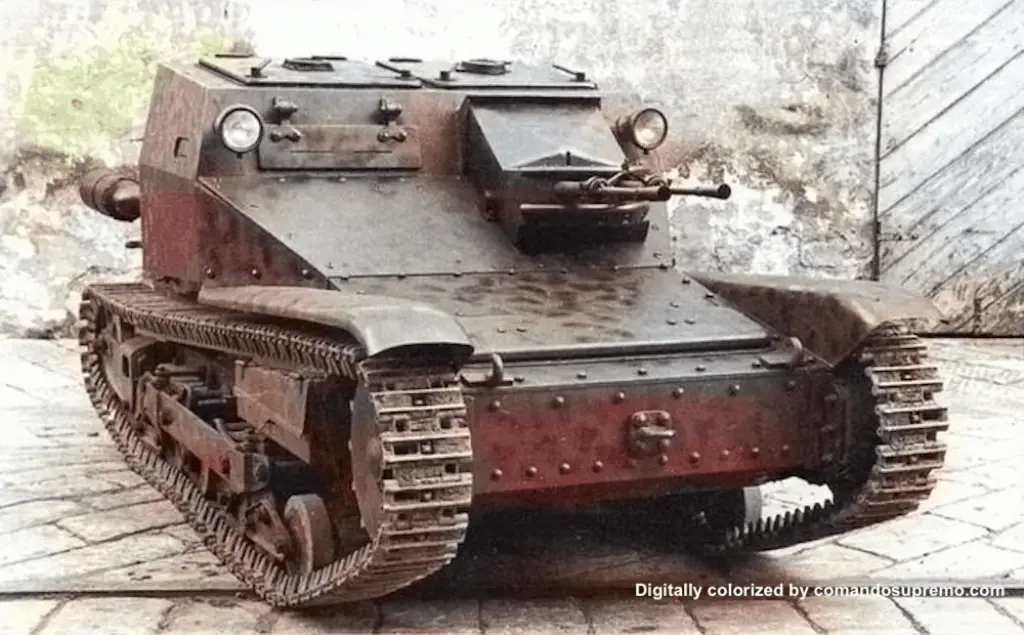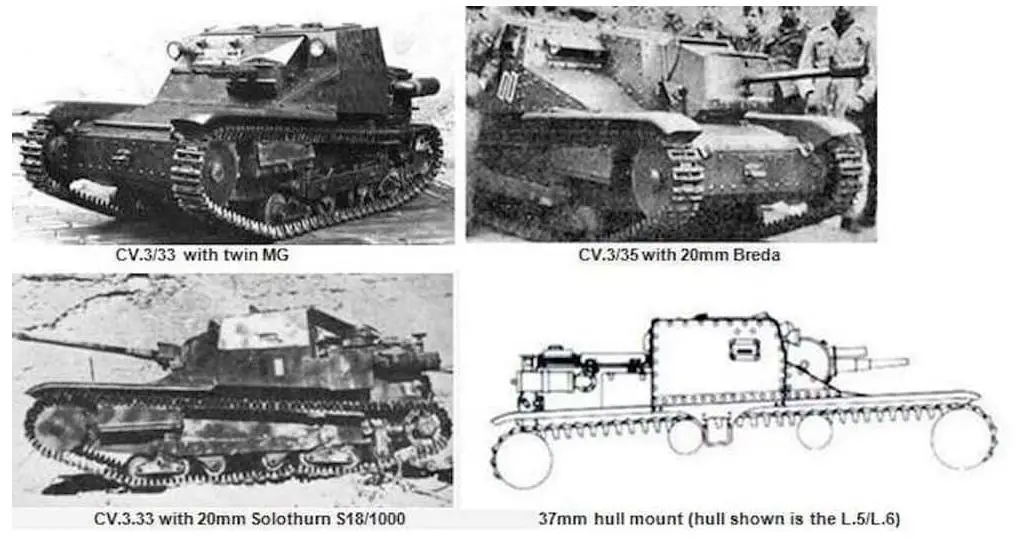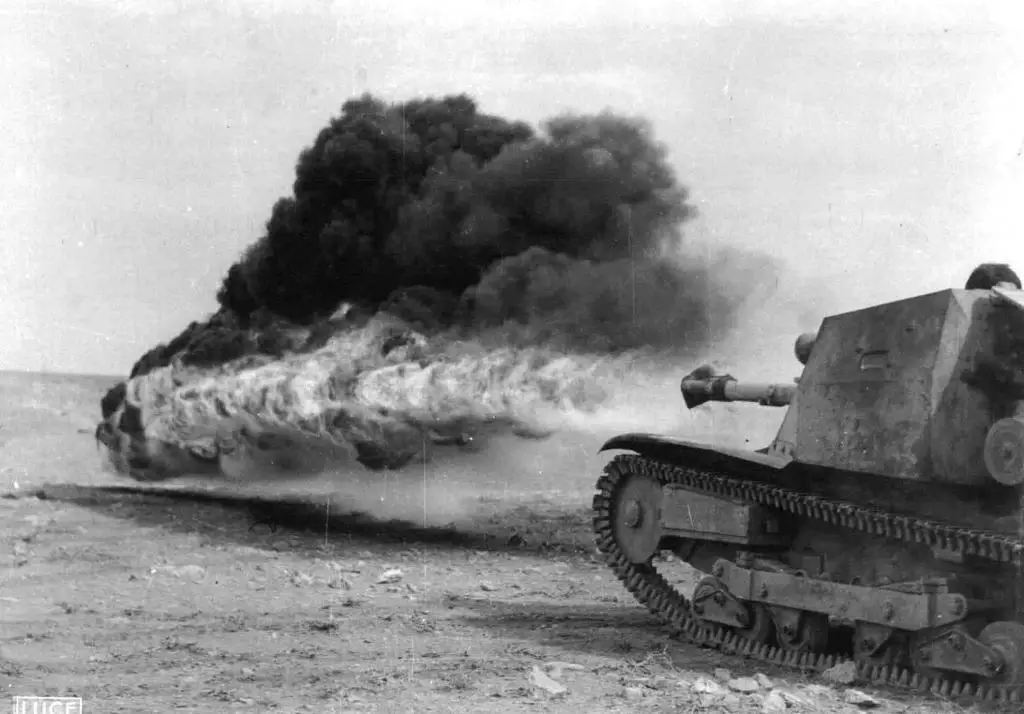Background on the Carro Veloce (Fast Tank) Tankette
Tankettes were a curiosity of the Second World War. In practical use, they occupied a space between armored cars, light tanks, and universal carriers. Many nations experimented with tankettes, but only a few retained them into the war years. Of those nations that utilized tankettes on a large scale, Italy relied the most heavily upon them. The distinction of most prolific tankette of the war goes to the Carro Veloce CV 33 or L3/33. The CV 35 or L3/35 was a marginal improvement upon the L3 33, the first domestically designed Italian tankette.

A digitally colorized image of a Carro Veloce CV 33 also known as the L3/33 tankette.
The L3/33’s began with the production of a small batch of 300 named the CV 33, beginning in 1933. The CV designation stood for ‘Carro Veloce’, or ‘Fast Tank.’ However, 1938 saw redesignation of the CV tankettes as the L3 series. The L standing for ‘Leggero’, meaning ‘Light,’ and the three designating weight in tons. This was part of the new system which classified Italian tanks by type, weight, and year. A few years later, the first of 2,200 L3/35’s entered production in 1935. The improvements were quite simple, and many L3/33’s became retroactively fitted to comply with them.
With the onset of WWII, the L3 tankettes would see ubiquitous service wherever Italian troops served. In Spain, Russia, North Africa, the Balkans, and Italy itself, the L3’s would see active combat careers.
Foreign Sales
The Carro Veloce CV 33 and CV 35 was somewhat successful insofar as global sales; over a dozen nations imported the Italian tankettes.
- China: 20 L3/33 tankettes
- Afghanistan: Unknown number
- Albania: Unknown number
- Austria: 72
- Bolivia: 14
- Brazil: 23 L3/33 and several L3/35’s
- Bulgaria: 14
- Croatia: 10
- Hungary: 65
- Iraq: 16
- Nationalist Spain: 2
- Venezuela: 2 L3/35s

A digitally colorized image of the Carro Veloce CV 35 also known as the L3/35 tankette in the Balkans.
About the Carro Veloce CV 33 and CV 35 Tankettes
The basic L3/33 design weighed 3.15 tons, and dimensions of 3.17 m in length, 1.4 m in width, and 1.3 m in height. The largest internal components were the two-man crew, who were required to sit at a nearly 90-degree angle. The two-man crew included a commander and a driver.
Armor was very thin, at 6-12 mm throughout, and could only resist small arms fire. Heavy machine guns and obsolescent, man-portable anti-tank rifles were dangerous to the L3. Additionally, bolted armor construction could result in spalling due to non-penetrating hits and high explosives. Bolts could sheer off and become dangerous projectiles, which might kill the crew. A single 6.5 mm machine gun marked the sole armament of the early models, although the armament experienced several upgrades.

A rear view of the L3/35 tankette in Albania, 1943.
The L3/33 derived its power from a FIAT-SPA CV3 water-cooled engine, capable of providing 43 horsepower. On the road, it would maintain a speed of 42km/h. Additionally, the L3 series utilized a bogie suspension system.
Armor and Armament Upgrades
The L3/35 saw the most substantial change, relative to the L3/33, in its armament. For example, two 8mm machine guns replaced the 6.5mm machine gun, a significant increase in firepower. Additionally, riveted armor replaced the bolted armor of the original design. While an improvement, riveted armor was still inferior to welded, cast armor.

A Carro Veloce CV 35 or L3/35 tankette in North Africa, 1941.
Other Variants Based On The L3 Chassis
While the majority of L3/33 or L3/35 tankettes were simple, medium machine gun-armed vehicles, the design involved other variants. The L3/38 represented a further evolution of the design but remained largely hypothetical. A new torsion bar suspension system replaced the bogie suspension system, and it received an armament of one heavy, 13.2 mm machine gun. However, interest in the tankette concept declined by 1938, and the L3/38 never entered mass production.

A Carro Veloce CV 33 also known as L3 33 Tankette momentarily airborne.
Additionally, there were anti-tank oriented variations. In Spain, the Nationalist-aligned forces were frequently troubled by the T-26 and BT-7 tanks of the Republicans. The Panzer I’s and L3 tankettes they possessed were simply outclassed, their machine guns incapable of retaliation. To solve the problem, Franco ordered tanks equipped with 20 mm guns. While the Italians began to prepare the order, it was ultimately canceled. Spanish leadership considered the Panzer I more suitable for the task, and a placed an order for up-gunned Panzer I’s.

Examples of L3 Variants.
In spite of that, a similar concept would see active use. One L3 variant mounted a semiautomatic 20 mm Solothurn anti-tank rifle, the L3 cc Anti-Tank. Their use was exclusive to North Africa but in small numbers. Although the 20 mm gun became obsolete against heavier British tanks, it was still effective against armored cars and light vehicles.
Finally, the L3 Lf (Lanciafiamme) tank carried a flamethrower and 520 liters of fuel. With the new armament, this L3 model had a much greater capability against entrenched opposition. One of the more widespread variants, the L3 Lf fought in Africa, Spain, France, and the Balkans.

L3 Lf Lanciafiamme (Flamethrower). Image: Luce
Service History of the L3/33 and L3/35
The first trial by fire of the L3 series occurred in Ethiopia, during the Second Italo-Ethiopian War. While advantageous in the poor terrain and against their poorly-equipped adversaries, the L3 still displayed vulnerability. In several documented instances for example, massed infantry defeated L3 tanks without any anti-tank weaponry. In Spain and Greece, the L3 tanks performed poorly against third-rate European armies. Finally, the catastrophic losses incurred during Operation Compass rendered them a much rarer sight in North Africa.
The L3 tankettes went on to see action in the Balkans and Eastern Europe, with Italian, Hungarian, and other armies. After the Italian surrender in 1943, Germany seized small numbers L3/33 and L3/35 tankettes. Subsequently, these units became utilized in the service of Germany’s remaining allies, particularly fighting partisans in the Balkans.
Specifications
| Specifications | Carro Veloce CV 33 & CV 35 |
|---|---|
| Class | Tankette |
| Crew | 2 Gunner/Driver |
| Weight | 3.15 Tons |
| Length | 10 ft 4 3⁄4 in (3.17 m) |
| Width | 4 ft 7 1⁄8 in (1.4 m) |
| Height | 4 ft 3 1⁄8 in (1.3 m) |
| Powerplant | FIAT-SPA CV3 water-cooled engine (43 hp) |
| Speed | 26 mph (42 km/h) |
| Operational Range | 78 mi (125 km) |
| Armament | Two 8 mm machine gun |
| Armor | 5-14 mm |
